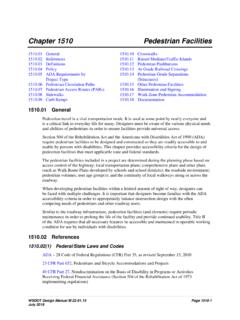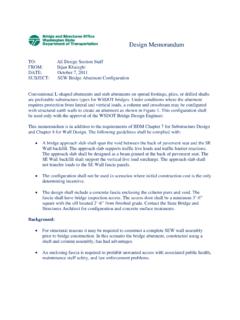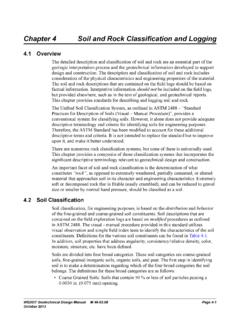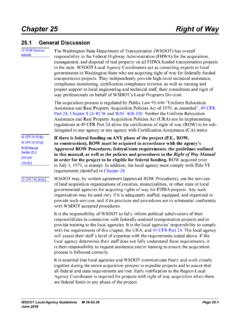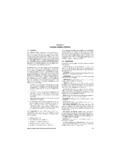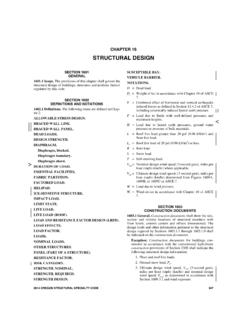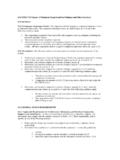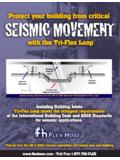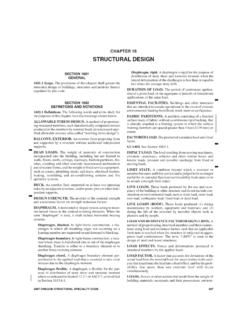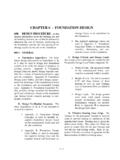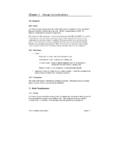Transcription of Chapter 6 Seismic Design - Washington State …
1 Chapter 6 Seismic Design Seismic Design Responsibility and Policy Responsibility of the Geotechnical Designer The geotechnical designer is responsible for providing geotechnical/ Seismic input parameters to the structural engineers for their use in structural Design of the transportation infrastructure ( , bridges, retaining walls, ferry terminals, etc.). Specific elements to be addressed by the geotechnical designer include the Design ground motion parameters, site response, geotechnical Design parameters, and geologic hazards. The geotechnical designer is also responsible for providing input for evaluation of soil-structure interaction (foundation response to Seismic loading), earthquake-induced earth pressures on retaining walls, and an assessment of the impacts of geologic hazards on the structures. Geotechnical Seismic Design Policies Seismic Performance Objectives In general, the AASHTO Load and Resistance Factor Design (LRFD) Bridge Design Specifications shall be followed for structure classification of bridges.
2 Critical, essential, and other structures are defined in AASHTO LRFD Bridge Design Specifications. In the current inventory, most structures are considered other with a few being essential or critical . In keeping with the current Seismic Design approaches employed both nationally and internationally, geotechnical Seismic Design shall be consistent with the philosophy for structure Design that loss of life and serious injury due to structure collapse are minimized. This performance objective shall be achieved at a Seismic hazard level that is consistent with the Seismic hazard level required in the AASHTO specifications ( , 7 percent probability of exceedance in 75 years for other structures, or lower probability of exceedance such as 2 percent in 50 years for critical or essential bridges, as determined by the State Bridge Engineer see Section The definition of structure collapse is provided in the LRFD Bridge Design Manual (BDM) M 23-50.)
3 Bridges, regardless of their AASHTO classification, may suffer damage and may need to be replaced after a Design Seismic event, but they are designed for non-collapse due to earthquake shaking and geologic hazards associated with a Design Seismic event. In keeping with the no collapse philosophy, bridge approach embankments and fills through which cut-and-cover tunnels are constructed should be designed to remain stable during the Design Seismic event because of the potential to contribute to collapse of the structure should they fail. The aerial extent of approach embankment (and embankment surrounding cut-and-cover tunnels) Seismic Design and mitigation (if necessary) should be such that the structure is protected against instability or loading conditions that could result in collapse. The typical distance of evaluation and mitigation is within 100 feet of the abutment or tunnel wall, but the actual distance should be evaluated on a case-by-case basis.
4 Instability or other Seismic hazards such as liquefaction, lateral spread, downdrag, and settlement may require mitigation near WSDOT Geotechnical Design Manual M Page 6-1. December 2013. Seismic Design Chapter 6. the abutment or tunnel wall to ensure that the structure is not compromised during a Design Seismic event. The geotechnical designer should evaluate the potential for differential settlement between mitigated and non mitigated soils. Additional measures may be required to limit differential settlements to tolerable levels both for static and Seismic conditions. The bridge interior pier foundations should also be designed to be adequately stable with regard to liquefaction, lateral flow, and other Seismic effects to prevent bridge collapse. All retaining walls and abutment walls shall be evaluated and designed for Seismic stability internally and externally ( sliding and overturning) , with the exception of walls that meet the AASHTO LRFD Bridge Design Manual no Seismic Analysis.
5 Provisions. With regard to overall Seismic slope stability (often referred to as global stability) involving a retaining wall, with or without liquefaction, the geotechnical designer shall evaluate the impacts of failure due to Seismic loading, as well as for liquefied conditions during and after shaking, if failure is predicted to occur. If collapse of the wall is likely during the Design Seismic event ( , does not meet minimum slope stability level of safety requirements during Seismic loading in accordance with Sections and ), and if that collapse is likely to cause loss of life or severe injury to the traveling public, the stability of the wall shall be improved such that the life safety of the traveling public during the Design Seismic event is preserved. As a general guide, walls that are less than 10 feet in height, or walls that are well away from the traveled way, are not likely to cause loss of life or severe injury to the traveling public.
6 Therefore, the wall Design may allow these lower height walls, or walls that are well away from the traveled way, to deform, translate, or rotate during a Seismic event due to inadequate Seismic stability. This also applies to reinforced slopes that are steep enough to require a facing such as a geosynthetic wrap or welded wire form, which is generally required for a face slope steeper that :1V. Note that the policy to stabilize retaining walls for overall stability due to Design Seismic events may not be practical for walls placed on marginally stable landslide areas or otherwise marginally stable slopes. In general, if the placement of a wall within a marginally stable slope ( , marginally stable for static conditions) has only a minor effect on the Seismic stability of the landslide or slope, or if the wall has a relatively low risk of causing loss of life or severe injury to the traveling public if wall collapse occurs, the requirement of the wall and slope to meet minimum Seismic overall stability requirements may be waived, subject to the approval of the State Geotechnical Engineer.
7 The State Geotechnical Engineer will assess the impact and potential risks caused by wall and slope Seismic instability or poor performance, and the magnitude of the effect the presence of the wall could have on the stability of the overall slope during the Design Seismic event. The effect on the corridor in addition to the portion of the corridor being addressed by the project will be considered. In general, if the presence of the wall could decrease the overall slope stability factor of safety by more than , the requirement to meet minimum Seismic overall slope stability requirements will not be waived, but this requirement may be waived by the State Geotechnical Engineer if the existing slope Seismic slope stability safety factor is significantly less than , subject to the evaluation of the impacts described above.
8 Page 6-2 WSDOT Geotechnical Design Manual M December 2013. Chapter 6 Seismic Design Cut slopes in soil and rock, fill slopes, and embankments should be evaluated for instability due to Design Seismic events and associated geologic hazards. Instability associated with cuts and fills is usually not mitigated due to the high cost of applying such a Design policy uniformly to all slopes statewide. However, slopes that could cause collapse of an adjacent structure ( , a bridge, building, or pipeline) if failure due to Seismic loading occurs shall be stabilized. Liquefaction Mitigation for Bridge Widenings The Policy For the case where an existing bridge is to be widened and liquefiable soil is present, the foundations for the widened portion of the bridge and bridge approaches should be designed to remain stable during the Design Seismic event such that bridge collapse does not occur.
9 In addition, if the existing bridge foundation is not stable and could cause collapse of the bridge widening, to the extent practical, measures should be taken to prevent collapse of the existing bridge during the Design Seismic event. The foundations for the widening should be designed in such a way that the Seismic response of the bridge widening can be made compatible with the Seismic response of the existing bridge as stabilized in terms of foundation deformation and stiffness. If it is not feasible to stabilize the existing bridge such that it will not cause collapse of the bridge widening during the Design Seismic event, consideration should be given to replacing the existing bridge rather than widening it. Specific Design and mitigation requirements to address the instability in the existing bridge to cause collapse of the new bridge widening will be assessed by the WSDOT.
10 Bridge and Geotechnical Offices. In accordance with executive departmental policy, the department may choose to defer liquefaction mitigation for the existing bridge, programming the implementation of the liquefaction mitigation of the existing bridge as part of the overall WSDOT Seismic retrofit program. See the Design Manual M22-01 Chapter 720 for the specific policy regarding this issue. Scoping for Bridge Widening and Liquefaction Mitigation Due to the high cost of liquefaction mitigation, it is extremely important that input be received from the Bridge Office and Geotechnical Office when developing the scope of bridge widening projects where liquefiable soils may be present, so that good project delivery decisions can be made. Therefore, the region project manager should contact the Bridge Office for bridge widening and retaining wall scoping assistance before project funding commitments are made to the legislature and the public.

